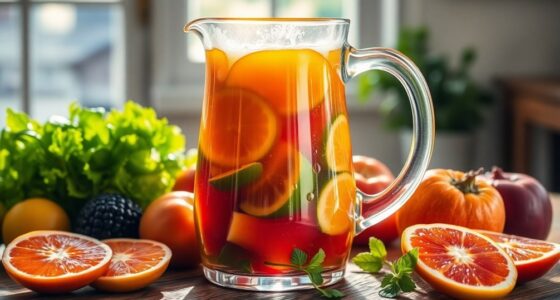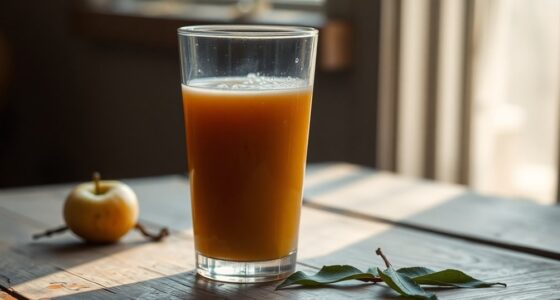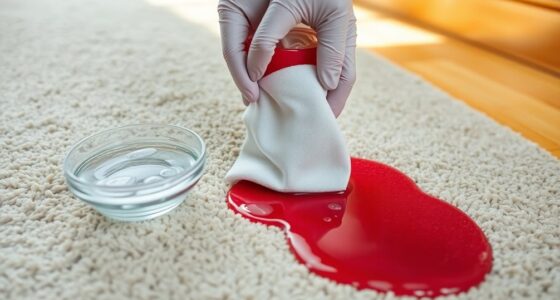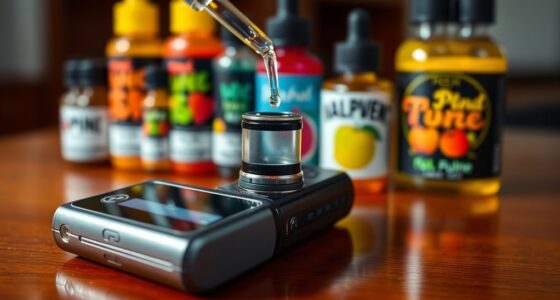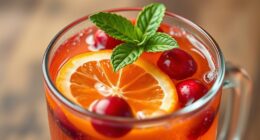To make homemade pickle juice, simply combine 2 cups of purified water with 1 cup of white vinegar, 2 tablespoons of kosher salt, and 1 tablespoon of pickling spice in a saucepan. Heat gently until the salt dissolves, then cool the mixture for about 10 minutes. Pack your choice of vegetables into mason jars, pour the cooled brine over them, and seal tightly. This tangy juice not only preserves veggies but has more surprising uses you might find interesting. Additionally, you can use leftover pickle juice in various recipes, such as salad dressings, marinades, or even as a tangy addition to cocktails. Some studies suggest that the vinegar in pickle juice may help manage blood pressure, making it an intriguing option for those seeking natural remedies. In fact, exploring cucumber juice benefits for hypertension could provide you with even more health advantages while enjoying your homemade brine.
Key Takeaways
- Combine 2 cups of purified water and 1 cup of white vinegar in a medium saucepan for the base of your pickle juice.
- Stir in 2 tablespoons of kosher salt and 1 tablespoon of pickling spice, heating gently until dissolved.
- Allow the mixture to cool for about 10 minutes, ensuring it is safe to handle before pouring into jars.
- Pack your choice of vegetables into mason jars, then pour the cooled brine over them for complete submersion.
- Seal the jars tightly and refrigerate for up to two months for optimal preservation and flavor enhancement.
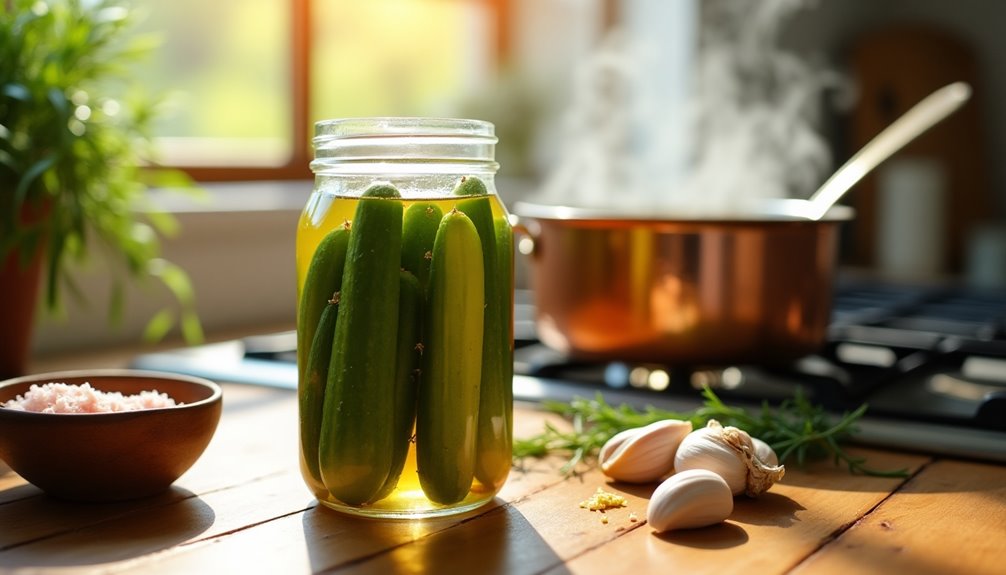
If you're looking to add a tangy kick to your meals or create a quick pickling solution, making homemade pickle juice is a simple and rewarding process. You don't need to be a culinary expert; just a few ingredients and a bit of time will get you there.
To start, gather your essentials: purified water, white vinegar, kosher salt, pickling spice, and a medium saucepan.
Begin by measuring out 2 cups of purified water and pouring it into your saucepan. Next, add 1 cup of white vinegar, ensuring it has at least 5% acidity for the best results. This acidity is what gives pickle juice its signature tang and helps preserve your pickles. To enhance the flavor, incorporate 2 tablespoons of kosher salt and 1 tablespoon of pickling spice. The pickling spice mix typically includes mustard seeds, coriander, and peppercorns, but feel free to customize according to your taste.
Once you've combined all the ingredients in the medium saucepan, turn on the heat. Stir the mixture gently as it warms up, allowing the salt and spices to dissolve completely. This process usually takes just a few minutes. You don't want to boil it; just heat it enough for everything to blend nicely.
After the salt has dissolved, remove the saucepan from the heat and let the mixture cool for about 10 minutes. This cooling period is essential; it prevents any potential scalding when you pour the liquid into your mason jars.
Now that your homemade pickle juice is ready, you can decide how you want to use it. If you like a hint of sweetness, consider adding a dash of sugar to the pickle brine before cooling. It's optional, but it can balance the acidity nicely.
Once the brine is cooled, it's time to get your mason jars ready. You can use these jars to store your quick pickling creations. Just pack your vegetables of choice—cucumbers, carrots, or even cauliflower—into the jars and pour the pickle juice over them, ensuring the veggies are fully submerged. For an extra touch, you can toss in fresh dill sprigs, which add a delightful flavor.
After sealing the jars, place them in the refrigerator. Your homemade pickle juice can be stored for up to two months, giving you plenty of time to enjoy your quick pickling endeavors.
Beyond being a great way to preserve vegetables, this pickle brine offers potential health benefits, like relieving cramps and providing hydration. So, whether you're craving a tangy side dish or just need a refreshing drink, you've got a versatile solution at your fingertips. Dive into the world of homemade pickle juice and enjoy the flavor and fun it brings to your kitchen!
Frequently Asked Questions
Can I Make My Own Pickle Juice for Leg Cramps?
Yes, you can definitely make your own pickle juice for leg cramps! This homemade remedy can help with hydration and muscle function, providing quick relief when you need it.
It's loaded with electrolytes like sodium and potassium, which are great for muscle recovery. Just mix the right ingredients, and you'll have a natural alternative to commercial sports drinks.
Plus, it's easy to store in your fridge for whenever cramps strike!
How to Make Pickle Solution at Home?
To make a pickle solution at home, you'll want to combine water, vinegar, salt, and any spices you like.
Start by heating the water and vinegar together, then add the salt until it dissolves. You can also throw in some sugar if you prefer a sweeter taste.
Once everything's mixed, let it cool before using.
Customize it with flavors such as garlic or red pepper flakes for a personal touch!
What Are the Main Ingredients in Pickle Juice?
The main ingredients in pickle juice are pretty straightforward.
You'll need 2 cups of purified water, 1 cup of white vinegar, and 2 tablespoons of kosher salt.
White vinegar's crucial because it preserves the veggies and gives that tangy flavor.
Kosher salt's preferred for its clean taste, but feel free to customize your juice with optional ingredients like pickling spice, sugar, garlic, or dill to suit your preferences.
Enjoy experimenting!
[DIRECTIONS]:How Long Does It Take a Cucumber to Turn Into a Pickle in Pickle Juice?
When it comes to pickling cucumbers, patience is a virtue.
You'll find that cucumbers take about 24 to 48 hours to begin transforming into pickles in the brine, with the best flavor developing around five days in the fridge.
If you slice them thin, they'll pickle faster.
For optimal taste and crunch, refrigerate them for at least two hours, but the longer, the better.
Enjoy your homemade pickles!
Conclusion
In the end, as you savor the crisp, tangy essence of your homemade pickle juice, think of it as a vibrant tapestry woven from simple ingredients. Each drop holds the promise of transformation, much like a seed blooming into a flourishing garden. You've not just crafted a flavorful brine; you've captured the essence of summer's bounty, preserving it for the chill of winter. So, relish your creation, and let it remind you of the joy found in the simplest pleasures.
Cindy thoroughly researches juicing trends, techniques, and recipes to provide readers with practical advice and inspiration. Her writing style is accessible, engaging, and designed to make complex concepts easy to understand. Cindy’s dedication to promoting the advantages of juicing shines through her work, empowering readers to make positive changes in their lives through the simple act of juicing.




